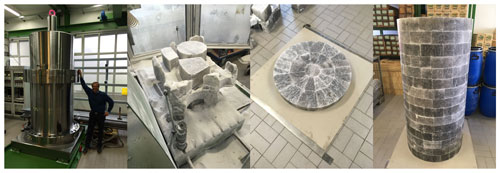Pilot plant tests to demonstrate the functionality of sealing elements made of salt cut bricks
The long-term safe containment of high-level radioactive waste in a repository in rock salt is ensured if the geological barriers in conjunction with the geotechnical barriers are permanently impermeable to fluids. As such, an essential factor in underground disposal is to confirm that the interfaces between the biosphere and the lithosphere, i.e., shafts, boreholes, and galleries, created during the excavation of underground cavities can be sufficiently tightly sealed. An essential element of the sealing system required to this end is shaft closure.
All shaft closure concepts developed thus far include sealing and supporting elements in repository shafts, but differ in the arrangement of these structural elements and the materials used. The materials currently proposed and planned for the construction of the sealing elements include: clay/bentonite, asphalt/bitumen, crushed salt, and salt/sorel cement.
In addition to the materials mentioned above, a research project funded by the German Federal Ministry for Economic Affairs and Energy (Bundesministerium für Wirtschaft und Energie, BMWi) is investigating the possibility of integrating a layer of salt cut bricks several decameters to 100 m thick into the shaft closure system as a sealing element that provides the option of allowing the geological barrier to heal in the long term. Like the surrounding rock mass, the salt cut bricks are made of natural rock salt. According to this plan, the profile of the bricks is designed to minimize joint volume as far as possible by cutting them to match the geometry of the shaft. The joints between the salt cut bricks can either be filled with, for example, a supersaturated salt solution, Magnesium building materials, molten salt, crushed salt, etc., or directly brought into contact by wetting the surface of the salt cut bricks. Once the salt solution has hardened (cooling of the solution, evaporation of the mixing water), only the pore space in the crushed-salt joint sealant filled with salt solution or air, or the joint volume resulting from the mismatch between individual rock salt bricks are susceptible to a reaction. This means that the sealing element consisting of salt cut bricks develops early supporting pressure against the creeping rock salt of the rock mass compared to crushed salt, has a low initial porosity and already shows a strong sealing effect in the short term (regression of the loosened zone). One can also assume that cohesive bonding between the surrounding rock and the sealing element can already be achieved by introducing the joint filling or by wetting the contact surfaces of the salt cut bricks (no or reduced separation planes in the contact zone).
Essential prerequisites for the investigation of the geomechanical-geohydraulic effectiveness of a sealing element made of salt cut bricks included the development and construction of a pilot plant to analyze the mechanical and hydraulic material properties of the bonding system comprising salt cut bricks and joint sealing (FKZ 02E11223, FKZ 02E11425), as well as preliminary investigations on the production of salt cut bricks and joint sealant (→ cutting technique/processing of salt cut bricks; maufacture/workability of jointing material) and on the spatial arrangement of the salt cut bricks (→ avoidance of continuous axial joints in the bonding system, Fig. 1).
The presentation includes the results of the research work on the development, construction and commissioning of the pilot plant, as well as the first successful test results demonstrating the functionality of sealing elements made of salt cut bricks.
Der langfristig sichere Einschluss hochradioaktiver Abfälle in einem Endlager im Salinar ist gewährleistet, wenn die geologischen Barrieren in Verbindung mit den geotechnischen Barrieren gegen Fluide dauerhaft dicht sind. Ein wesentlicher Gesichtspunkt der untertägigen Deponierung ist vor diesem Hintergrund der Nachweis, dass die im Rahmen der Auffahrung untertägiger Hohlräume geschaffenen Verbindungen zwischen Biosphäre und Lithosphäre, d. h. Schächte, Bohrungen und Strecken, ausreichend dicht verschlossen werden können. Ein wesentliches Element des hierfür erforderlichen Abdichtungssystems ist der Schachtverschluss.
Alle bisher entwickelten Schachtverschlusskonzepte beinhalten Dicht- und Tragelemente in Endlagerschächten, unterscheiden sich jedoch in der Anordnung dieser Bauelemente sowie den hierfür zum Einsatz kommenden Materialien. Als Materialien für den Bau der Dichtelemente werden aktuell vorgeschlagen und geplant: Ton/Bentonit, Asphalt/Bitumen, Salzgrus sowie Salz-/Sorelbeton.
Über die vorstehend genannten Materialien hinaus wird im Rahmen eines vom BMWi finanzierten Forschungsvorhabens untersucht, als Langzeitdichtelement mit der Option, eine langfristige Verheilung der geologischen Barriere zu ermöglichen, eine mehrere Dekameter bis 100 m mächtige Schicht aus Salzschnittblöcken in das Schachtverschlusssystem zu integrieren. Die Salzschnittblöcke bestehen wie das anstehende Gebirge aus natürlichem Steinsalz. Ihre Profilierung erfolgt planmäßig unter der Zielstellung einer weitgehenden Minimierung des Fugenvolumens durch einen an die Schachtgeometrie angepassten Zuschnitt. Die Fugen zwischen den Salzschnittblöcken können optional z. B. mit einer übersättigten Salzlösung, Mg-Baustoffen, einer Salzschmelze, Salzgrus usw. verfüllt oder unmittelbar durch eine Befeuchtung der Salzschnittblockoberflächen in Kontakt gebracht werden. Nach dem Aushärten der Salzlösung (Abkühlung der Lösung, Verdunstung des Anmachwassers) sind lediglich der durch Salzlösung bzw. Luft gefüllte Porenraum der Salzgrusfugenfüllung bzw. das durch ein „mismatching“ einzelner Salzschnittblöcke resultierende Fugenvolumen einer Kompaktion zugänglich, sodass das Dichtelement aus Salzschnittblöcken einen im Vergleich zu Salzgrus frühen Stützdruck gegen das aufkriechende Steinsalzgebirge entwickelt, eine geringe Anfangsporosität besitzt und schon kurzfristig eine hohe Dichtwirkung aufweist (Rückbildung der Auflockerungszone). Auch ist davon auszugehen, dass bereits mit Einbringung der Fugenfüllung bzw. Befeuchtung der Salzschnittblockkontaktflächen ein kohäsiver Verbund zwischen dem anstehenden Gebirge und dem Dichtelement realisiert werden kann (keine bzw. reduzierte Trennflächen in der Kontaktzone).
Wesentliche Voraussetzungen für die Untersuchung der geomechanisch-geohydraulischen Wirksamkeit eines Verschlusselements aus Salzschnittblöcken waren die Entwicklung und der Bau eines Technikumsprüfstandes zur Analyse der mechanischen und hydraulischen Materialeigenschaften des Verbundsystems aus Salzschnittblöcken und Fugenfüllung (FKZ 02E11223, FKZ 02E11425) sowie Voruntersuchungen zur Herstellung von Salzschnittblöcken und Fugenmaterial (→ Schnitttechnik/Bearbeitung Salzblöcke; Herstellung/Verarbeitbarkeit Fugenmaterial) und zur räumlichen Anordnung der Salzschnittblöcke (→ Vermeidung axial durchgängiger Fugen im Verbundsystem, Abb. 1).
Im Rahmen des Vortrages werden die Ergebnisse der Forschungsarbeiten zur Entwicklung, Konstruktion und Inbetriebnahme des Technikumsprüfstandes sowie erste erfolgreiche Versuchsergebnisse zur Demonstration der Funktionalität von Abdichtungselementen aus Salzschnittblöcken präsentiert.





